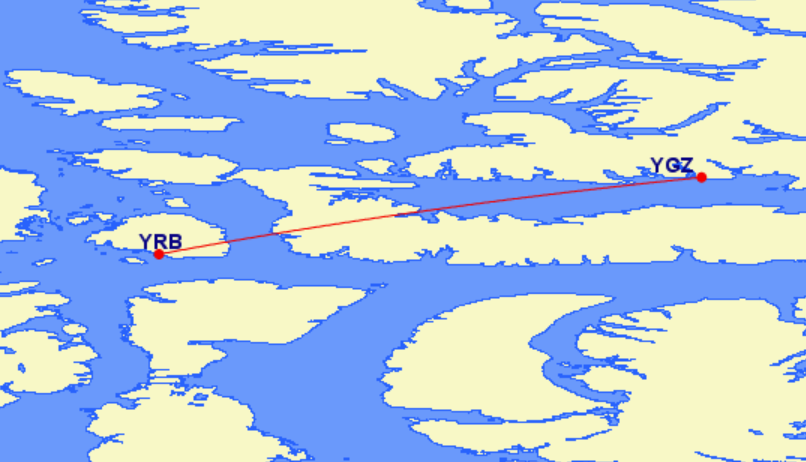I find aviation in Canada fascinating, although I know comparatively little about it. So I wound up heading down a rabbit hole over an online complaint about the high cost of Arctic flying.
The 239-mile flight from Grise Fiort (YGZ) to Resolute (YRB) was pricing out at CAD$3,793.99 (US$2,745.48) roundtrip.
Almost 4k just to get to other town in high Arctic, From Grise Fiort to Resolute Bay, high coat of living in Arctic is Real. pic.twitter.com/1nCJhRQ5yc
— Tony Uluadluak (@AniUluadluak4) September 22, 2025
This is a Canadian North flight operated by Kenn Borek Air. And it’s expensive. With a two week advance purchase you’re looking at a still-expensive but lower US$1,864 roundtrip. In fact, price doesn’t appear to go lower than that all year right now.

Kenn Borek operates 19 de Havilland Canada DHC-6 Twin Otter; 6 Beechcrafts; and 10 Douglas DC-3s. The Calgary-based airline has significant operations out of Punta Arenas, Chile in winter flying to Antarctica.
This particular flight is operated twice a week with DHC-6s, which are generally 19 passenger aircraft. And if this was actually a cash cow, you’d expect some other operator to enter the market.
The reason it’s so expensive is a combination of limited seat supply, specialized aircraft, and brutal operating constraints. You’re paying for an Arctic air bridge on this route – not so much for a 239‑mile hop.

Here’s what pushes the fare into the thousands:
- Only STOL aircraft can land at Grise Fiord. YGZ is a 1,675 foot gravel strip hemmed in by mountains. That excludes larger, economical plane types. The DHC‑6 Twin Otter has very high cost per seat mile compared to ATRs or a 737. Meanwhile, Resolute’s runway is long at 6,504 feet but is also gravel. Even Canadian North’s 737‑400s can’t use gravel strips.
- Microscopic seat supply. Scheduled service to Grise Fiord is twice weekly in each direction. A Twin Otter with 19 seats operating twice a week means just 38 weekly seats before weight, cargo, and weather constraints. When demand (medical travel, government duty travel, essential trips) runs headlong into that supply, close-in bookings get extremely expensive.
- Flight distance isn’t the driver of cost. On very short sectors with small turboprops, crews, maintenance, deicing, ground handling, and station overhead are cost drivers. And those costs amortize across a very small number of seats.
- Arctic operating constraints. Fuel can be scarce or unavailable at outstations, meaning that it has to be tankered in – which means reduced payloads and seat caps. In 2022, both Grise Fiord and Resolute had no fuel available, causing flight cancellations and reduced seating capacity due to carrying extra fuel.
- Weather and reliability buffers. These route see frequent weather cancellations, driving up irregular operatoins costs.
- Cargo competes with passengers. These flights bring in food, medicine and mail. Cargo trades off with passengers due to weight. Add in cargo on top of tankered fuel and operating in weather that provides little margin, the carrier has to limit seat capacity. That also means amortizing costs across fewer seats. And ticket price has to reflect the revenue that makes this operation worthwhile.
On a route like this you’re not buying 239 miles of flying, you’re buying access to the northernmost scheduled airfield in Canada, constrained to short takeoff and landing turboprops, with just a handful of seats, lack of fuel, cargo priority and in harsh weather.
What’s the best deal out there for these flights? Aeroplan.

Canadian North is an Aeroplan partner. Six months ago this flight would have cost just 6,000 Aeroplan points each way. When Aeroplan moved to variable pricing on partners like Etihad and United I shrugged at the inclusion of Canadian North, since that didn’t seem so relevant to me at the time. It was actually quite a meaningful change. Nonetheless, the best bet here is planning ahead with points.
(HT: @PFDigest)


The government could pave the runway if it’s important to it to lower those costs.
Woah. That’s wild, Gary. Thank you for sharing these kinds of unique finds. Have fun with the polar bears, if you go!
Fascinating! What a cool find, Gary. Would be a neat experience to check out that part of the world. (And great if you need to spend to spend for a SUB!)
@Daniel – Paving runways in these remote areas just isn’t a thing. The maintenance with permafrost is exorbitant and not cost effective. The government would be better off just fully subsidizing the flights. I am unsure of the subsidies on this specific route, but they subsidize many Canadian North routes in Nunavut.
Interesting and well laid out, Gary. Thanks for sharing.
And Daniel, I haven’t been to the sites discussed, but did have the pleasure of visiting the Yukon, northernmost Alaska and walked around a little of the Antarctic Peninsula. From that I can say that paving is not a great idea as temperature variations in the ground, with resulting heaving, can lead to rapid cracking and shifting of hard structures. A steel pad might be possible though that wouldn’t necessarily extend the runway.
Don’t these people know they can move? There’s no gate. You can just leave.
@Michael — Ah, yes, telling the ‘natives’ to just ‘move.’ No biggie. Also, could they please, like, ‘no longer exist,’ too. It’d be super helpful so that we can just pillage the minerals under their land. Thanx. K. Byeee. (A tale as old as time.)
Almost forgot, bonus points if you refer to ‘indigenous’ people as ‘savages,’ and if you suggest that if only they’d ‘read the Bible’ then they’d be more ‘civilized.’ (@Walter Barry, @David R. Miller, and the other resident bigots, is that it?)
(Sarcasm above)
In all seriousness, I wonder if our Canada-based commenters, like @Steve M (I think), have any thoughts on these unique air services, and if they (or anyone they know) has actually taken them.
My one quibble with this coverage is the statement that cargo makes even fewer seats to spread costs over…. that’s not how air travel works. Cargo is more stuff to spread the costs over, and cargo only displaces passengers when it’s more economical to fly than the passengers are.
MOST times, flying the passengers is only as economical as it is BECAUSE of the cargo!
@Daniel: 19x2x52 is basically 2,000 passengers/year, if every flight goes and every flight is full. That’s only $4 million/year in passenger revenue. Paving a runway makes no sense.
I have relatives who work the Far North of Canada, mostly as teachers, medical personnel, and law enforcement. It pays very well, but requires a certain psychology to be able to do it. This is how they get in and out. In the old days, you went by ship or just didn’t go. You did without and died in place. Polar bears and wolves still share Main Street with the humans. The frontier still exists, even if you can fly there.
@1990, what are you talking about? This has nothing to do with being a native or existing. There’s a reason nobody else lives there, and it’s cause it’s goddamn cold and there’s 2 hours of sunlight. It sucks. If you want to make any sort of statement that you’re going to continue preserving the culture of your ancestors by homeschooling your kids and putting on snow shoes to drive your sleigh to the mailbox and hunting your lunch, that’s fine. I don’t care. Just don’t complain that airfare cost $4,000 to fly to the place where no one wants to live and you need an airplane for you to get your mail.
Everyone loves to criticize government subsidies until it’s something they want, need or think is valuable.
Easy for me to say this is a good thing or a bad thing. But, without context and understanding of why these investment matter and what ROU they deliver any opinion I have is ill-informed.
Resolute Bay is a big mining outpost and mining companies have a lot of money to spend on getting workers and gear back and forth.
@Michael — Have you tried visiting in summer? Try 24-hours of sunlight.
@1990, summer is the worst time, very disorienting. Have a cousin who worked in Inuvik for two years. Summers are the worst with it never getting dark. Even with the tin foil on the windows, there are kids playing outside at all hours. Also have a friend who is a pilot for these flights. Went to work for Canadian North directly but flying their planes and landing on regular runways was too boring for him, so he went back to contract flying into tiny gravel strips like these ones. Had a classmate who was chief pilot for Canadian Helicopter and flew into these areas on a regular basis. Sometimes contracted to herd caribou and reindeer! It is definitely a lifestyle thing, not for everyone (including me!).
@farnorthtrader — And, if it’s anything like Alaska, the mosquitoes are like the size of small birds, and they bite like crazy!
@1990 – Worse, they have horseflies! Those suckers will bite a person (or a horse, a moose, etc). And it hurts!
‘Almost forgot, bonus points if you refer to ‘indigenous’ people as ‘savages,’ and if you suggest that if only they’d ‘read the Bible’ then they’d be more ‘civilized.’ (@Walter Barry, @David R. Miller, and the other resident bigots, is that it?)’
@1990 I enjoy so many of your posts. But would you consider waiting until someone makes a comment before attacking them. Attacking someone for what they say … before they’ve said anything – seems a bit… not who we want to be. And no, ‘sarcasm’ doesn’t abate the issue, which you’ve done enough to note.
@1990, not I’m not planning on visiting. And no, 24 hours of sunlight isn’t a good thing either.
Having been a pilot in Alaska and the Northern Territories, I’m going with Michael and Farnorthtrader’s comments…1990, just more opinion. BTW 1990, summer north of the Arctic Circle for that “24-hours of sunlight” is June 21, pretty much every year. The rest of the year is so depressing even the salmon leave. I found summer in Alaska to be similar to winter in Houston. But you got the mosquito thing right! I suspect they outweigh any other native wildlife.